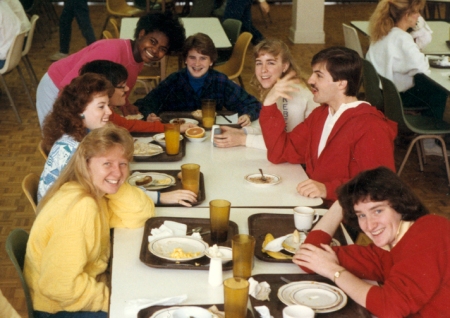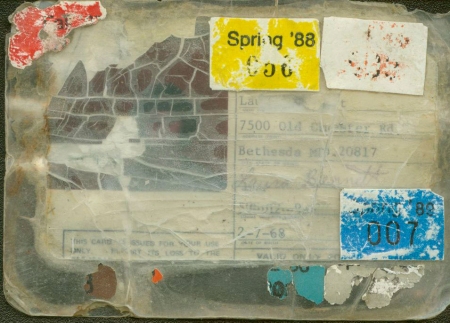When I was little, every so often my Mom would make up a big pot of pork chops in barbecue sauce for supper. I always loved the flavor, and how tender the meat was. When she made it, she usually used bone-in chops and cooked them in the sauce in the oven for a couple hours. The end result was very tasty and very “saucy,” and the only thing I didn’t really care for was the fact that I had to pick out the bones while eating dinner.
I started cooking this dish myself a couple years ago when I discovered the sauce recipe with Mom’s name on it in an old church cookbook. I have tweaked it so that the end result resembles something more like a pulled pork barbecue (even though the pork isn’t pulled). And I must say… YUM. This stuff is absolutely, 100% addictive. Which is to say, I doubt you can ever just take a bite and walk away. It’s hard to stop eating it! Very. Difficult. To. Stop.
Totally Addictive Pork Barbecue (by Laura, with apologies to Mom)
First, buy some pork chops. I have used boneless, bone-in, thick, thin, butterfly… you really only need the inexpensive “assorted chops” that you can often find in the meat case, but I have used the higher priced cuts when I don’t feel like messing with bones. Basically, I will snap up any of the meat when it gets marked down at the grocery, then put it in the freezer and make barbecue when I have several pounds of it to make use of. So… buy whichever cut you prefer, just make sure you have plenty of it. It’s nice to make a nice big pot of this stuff. I promise, it won’t last long.
To make the pot shown in the photo above, I had two trays of frozen “assorted chops” from the freezer section at Aldi, plus one other tray of assorted chops that had been just marked down at the Wal-mart grocery. The exact quantity of meat isn’t crucial. I let the frozen chops thaw about a day in the fridge to get them at flexible enough to work with.
Once you have your meat on hand and ready to work with… set it aside and get the sauce going first. 🙂
Set a large dutch oven on the stove top over medium-high heat with a couple tablespoons of canola oil in the bottom. Add 2 medium onions (chopped) and about 1 cup of chopped celery… let it start to cook and brown a bit. Add 2 cloves of minced garlic toward the end of browning time (so the garlic doesn’t burn).
To the mixture in the pan, add:
- 3 cups water
- 1 1/2 cups ketchup
- 1/4 cup worcestershire
- 1/4 cup vinegar
- 1/4 cup brown sugar
- 2 tbsp. lemon juice (or the juice of one large lemon)
- 2 tsp dry mustard (I usually just add a little prepared mustard)
- 2 tsp salt
- 1 tsp pepper
Stir it all together and let it reach a boil, then cut the heat back and let it simmer a bit OR just turn the heat off but leave the pan on the burner while you prepare the chops.
Now, pull out a large frying pan or something similar that you can brown your chops in… I like to use a cast-iron skillet. Turn the burner on medium-high to high heat and add a touch of oil to keep the chops from sticking too much. Add the chops in batches so that they can brown a bit before adding them to the sauce. If you are using bone-in chops, I guess you could leave the bones intact and pull them out of the pot after they’ve cooked, but I prefer to remove any bones before cooking because I don’t like to deal with them later.
Anyway, brown up the chops a few at a time, adding them to your dutch oven as you go. You may need to refresh your frying pan with a little oil between batches. Remember that the chops don’t have to cook through in the frying pan… you are just looking for some browning action to help with the flavor of the dish.
However much meat you are using, try to make sure the chops are fairly submerged in the sauce. Poke around and tuck them in as best you can. They don’t have completely disappear beneath the surface… once they start to cook down it should all work itself out… but there should be enough sauce to keep them from drying out.
Once all the chops are in the sauce, look at your frying pan. Did you get a nice brown layer of tastiness on the bottom? Good! Now de-glaze that pan with a bit of tap water while the burner is still on… just enough water to loosen up the brown bits with a spatula. Then pour that liquid into your dutch oven with the chops and the sauce. and give it all a stir.
Oven temperature and cooking times can vary depending on how much time you have before you need to serve supper… but the general rule is, the longer you can let it cook, the better the end result. Here is the process I used to get the results shown above:
- Cover the dutch oven and put in the oven at 300º
- After about 5 hours, uncover the pan, stir and break up the pork into smaller pieces (it should be at the falling apart stage by then)
- Turn heat down to maybe 225º and put the pan back in, uncovered.
- Let it cook down and caramelize as long as you can stand to wait. Maybe another 2 or 3 hours? Turn the heat down even lower if you like, and do peek in now and then to give it a stir. If it looks like it might get too dry, put the lid back on.
This barbecue can be served in sandwiches OR plated up with your favorite side dishes.
Also, you can just stand there at the stove and eat it right out of the pan. It’s been known to happen. I’m just saying.








